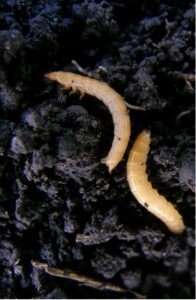Section Title
Wireworms in Manitoba
- Whole Farm
Manitoba farmers are well aware of the destructive abilities of wireworms. They feed below ground on many different crop types, causing early season plant stress. Feeding also results in thinning plant populations and reduced yield.
What are Wireworms?
Wireworms are the larval stage of click beetles and are soil dwelling. There are many different wireworm species in Canada, with the prairie grain wireworm (Selatosomus aeripennis destructor) and Hypnoidus bicolor (no common name) being the most prominent species in the Prairies. In Manitoba, Hypnoidus bicolor is the most dominant species. In a survey of wireworms from farms across the Canadian Prairies from 2004 to 2019, 93 per cent of the wireworms from Manitoba were Hypnoidus bicolor. Wireworms are hard-bodied, slender, segmented, worm-like insects, although they are not actually worms (Manitoba Agriculture, n.d.). They are jointed, with three pairs of short legs on the underside of their bodies and behind their head (Catton et al, 2021).
Table 1. Most common species of wireworms found in Manitoba and select identifying characteristics.*
| Species | Colour | Length (mm) | Importance in MB |
| Hypnoidus bicolor | pale-yellow | 10-12 | high |
| Prairie grain wireworm | yellow-orangish | 20 or less | medium - high |
| Flat wireworm (Aeolus mellillus) | brown or reddish-brown | 15 or less | low - medium |
*Table information gathered from Catton et al (2021).
Most wireworm species follow a similar life cycle, spending most of their life living in the soil in a larvae stage. Wireworms can live for multiple years in the larvae stage. It is at this stage of their life cycle when most crop damage occurs and is most severe. More information about wireworm life cycles can be found in the section, below. More information regarding the appearance and characteristics of different species of wireworms can be found here.
Figure 1. Wireworm larvae in soil (Photo credit: Dr. John Gavloski).
Wireworm Lifecycle
Wireworms are click beetle larvae. Adult click beetles do not directly damage crops. Adult click beetles overwinter in the soil and lay eggs shortly after emerging in the spring. In the summer, eggs hatch, but newly hatched wireworms (neonates) are not usually damaging to crops. Wireworms are most damaging after their first winter (Catton et al, 2021). The length of the larvae stage differs by species. It can last more than five years for some species, but Hypnoidus bicolor is thought to have a two- to three-year larval period (Catton et al, 2021). A great illustration of the click beetle life cycle can be found here, on page 18.
Host Crops and Damages
Wireworms will feed on a variety of crops, including cereals, sunflowers, peas and corn. Wireworms are attracted to CO2 produced during seed germination and respiration. Most feeding occurs during the spring to early summer; this is the most destructive feeding period (Catton et al, 2021). Wireworms damage seeds, roots and below-ground plant parts, typically shredding and chewing stems or hollowing out seeds. Symptoms of wireworm feeding can also be seen in young seedlings, with the centre leaves looking wilted and yellow. These plants will die soon after showing this symptom.
Economic Threshold, Scouting Techniques and Control
There are no economic thresholds established for wireworms and no insecticides registered for control of click beetles (adult wireworms). Therefore, cultural practices and seed treatments are the primary mechanism to reduce wireworm damage.
Wireworm scouting can take place pre- or post-seeding. Investigate areas where seeds didn’t germinate or there are thin and weak stands, especially during early stages of crop development. If scouting post-germination, dig up plants in the bare patches and on the periphery of the damaged area. Look for holes in seed or torn and shredded roots and emerging tissue. Buried bait traps can be used to identify wireworm populations present in a field, providing there are not a lot of crops or weeds that can provide a competing CO2 source (Manitoba Agriculture, n.d.). These traps should be placed across areas with suspected infestation areas. There are a few different baits used for wireworm bait traps, with most being placed 10-15 cm in depth and checked for wireworms 7-10 days later (Manitoba Agriculture, n.d.). More information on different bait traps can be found here.
Best management practices
- Insecticide seed treatments are available for wireworms in small grains (wheat and barley), sunflowers and corn, plus other crop types. These treatments only target feeding wireworms. Most of these seed treatments reduce wireworm damage by temporarily intoxicating and repelling the wireworms, but they are not necessarily killed (Catton et al, 2021). Therefore, a large scale population reduction doesn’t occur when using these seed treatments (Catton et al, 2021). A relatively recently registered seed treatment for wheat and barley, containing the active ingredient broflanilide, does kill wireworms. These insecticides should be used only when wireworm management is necessary, as overuse can increase the risk for resistance development. Refer to the Manitoba Field Crop Protection Guide and here for more information on seed treatments (Manitoba Agriculture, n.d.).
- Plant less susceptible crops in fields known to have wireworm infestations, such as buckwheat and mustards (Catton et al, 2021). However, crop rotations don’t guarantee successful reduction of wireworm populations (Catton et al, 2021).
- Seed into warm and moist soils, as this helps promote quick germination. Early crop growth may reduce damage from wireworms. Shallow seeding depth may also speed up early growth of plants if moisture is available (Manitoba Agriculture, n.d.).
- Natural enemies feed on wireworms. These include ground beetles, rove beetles and larvae of stiletto flies (Manitoba Agriculture, n.d.).
There are several similar insect species that resemble wireworms, including cutworms, stiletto fly larvae, crane fly larvae, seedcorn maggots and centipedes. Photos of these insects can be found here.
References
- Manitoba Agriculture. n.d. Wireworms on crops in the Canadian prairies [internet]. Carman (MB); [Cited 2024 May 13]; [1 page]. Available from: Province of Manitoba | agriculture - Wireworms (gov.mb.ca)
- Catton H, Van Herk W, Saguez J, Svendsen E. 2021. Guide to pest wireworms in Canadian Prairie field crop production. Lethbridge (AB): Agriculture and Agrifood Canada. 77.












